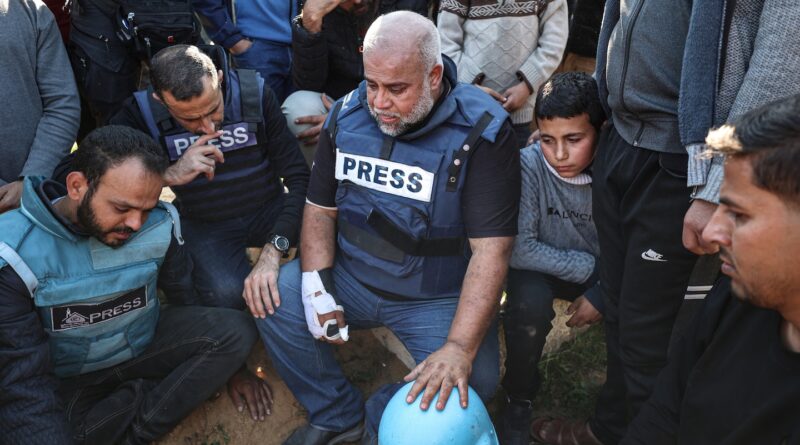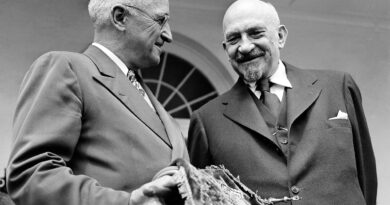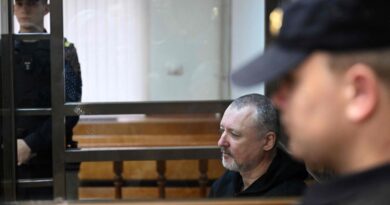Analysis | Israel’s Gaza war leads to a massacre of journalists
As the Gaza bureau chief for the influential Qatar-based news network, Dahdouh reported on the weeks of war that followed. The aperture of the Israeli campaign widened, reaching Gaza’s south. In December, Dahdouh was wounded and his cameraman killed in an Israeli drone strike while they were reporting from the southern town of Khan Younis. He was back reporting the next day. Over this weekend, tragedy struck again when another apparent Israeli drone strike targeted a car carrying a group of journalists on assignment close to Rafah along Gaza’s border with Egypt. The attack killed two Palestinian journalists — his son, Hamza al-Dahdouh, and Mustafa Thuraya.
A grieving Wael said in a video that emerged later that Hamza was “my breath and my soul,” a sentiment Hamza had reciprocated in what ended up being one of his last social media posts. Their family’s compounded suffering has served as a potent snapshot for what thousands of Palestinian families in Gaza are enduring amid daily bombardments and a constant search for food and the basic necessities for survival.
“In a video posted on social media, Wael is shown at Hamza’s wedding in 2022, all smiles and arms thrown wide open as guests chucked him, the groom’s father, aloft, and then caught him again,” my colleagues reported. “On Sunday, he looked empty, standing over Hamza’s body at the morgue, clutching his hand and muttering softly. Later, he wrapped his arms around Wafaa, his son’s inconsolable widow, as she placed her face on Hamza’s chest.”
According to a tally maintained by the Committee to Protect Journalists, at least 79 journalists and media workers have been killed since the start of the war on Oct. 7. Local Palestinian authorities put that number above 100. In either case, it’s the single biggest death toll for journalists in a conflict zone for years — surpassing the toll exacted on the press operating in Ukraine over the past two years in just a matter of months. By one estimate, 1 out of every 10 journalists in the Gaza Strip has already been killed.
Israeli authorities claimed the strike that killed Dahdouh’s son was targeting a “terrorist” inside the car who was operating a drone that put Israeli forces “at risk.” Gazan journalists have, for weeks, used drone footage to document the scale of destruction wrought by Israel’s bombardments.
In response to an earlier story on slain journalists by my colleagues in November, the Israel Defense Forces sent The Washington Post a statement where it blamed militant group Hamas for endangering civilians, including journalists, with their operations.
“The IDF does not purposefully target journalists, and takes measures to mitigate unintended harm to journalists and all civilians,” the statement said, adding that the military was “targeting all Hamas military activity throughout Gaza,” which entailed “high intensity strikes, which may cause damage to surrounding buildings and areas.”
Such explanations are insufficient to media organizations and rights groups. Al Jazeera accused Israel of “violating principles of freedom of the press” and deliberately targeting the journalists. “The killings of journalists Hamza Al Dahdouh and Mustafa Thuraya must be independently investigated, and those behind their deaths must be held accountable,” said CPJ’s Sherif Mansour in a statement. “The continuous killings of journalists and their family members by Israeli army fire must end: journalists are civilians, not targets.”
Before the war, Israel’s critics long bemoaned the relative impunity with which its military acted in the Palestinian territories. To this day, no Israeli soldier or official has suffered any consequences for the killing of Al Jazeera journalist Shireen Abu Akleh in the West Bank town of Jenin. Abu Akleh was also a U.S. citizen, yet the Biden administration, while a staunch defender of press freedom worldwide, only paid lip service to the need for accountability.
It did the same over the weekend. “I am a parent myself, I can’t begin to imagine the horror that he has experienced, not once, but now twice,” Secretary of State Antony Blinken told reporters during a stop in Qatar, referring to Dahdouh’s ordeal. “This is an unimaginable tragedy and that’s also been the case for far too many innocent Palestinian men, women, children.”
Gaza’s remaining journalists are operating in the world’s most challenging and dangerous environment for the media. When not attempting to track developments on the blurred, battered front lines, they are documenting their own daily struggles to simply get by, from gathering water, to searching for internet, to mourning lost relatives and friends.
In November, Youmna Elsayed, another Al Jazeera correspondent in Gaza, described to my colleagues the trauma of visiting hospitals full of the dead and wounded. “You’re constantly seeing bodies in front of you. You’re constantly seeing injuries,” she said. “It haunts me at night. It haunts when I want to eat. It haunts me when I want to sit and rest. You can’t get any peace.”
On Sunday, after Hamza’s killing, she posted an image of him on social media with the caption, “too much pain, too much heartache … we can’t take it anymore.”
But Dahdouh, like many of his colleagues, is carrying on. In a video widely shared on social media Monday, he said he would keep reporting in the memory of his fallen family. “As long as we are alive and as long as we are able to perform this duty, we will do so without hesitation,” he said.




